As the colder months approach, many households turn to gas heaters for their efficient heating capabilities and cost-effectiveness. However, while gas heaters can keep your home cozy, they also come with health risks if not properly maintained and used. TrueTemp HVAC is here to educate you on the potential health risks associated with gas heaters and provide guidance on how to use them safely.
Potential Health Risks from Gas Heaters
1. Carbon Monoxide Poisoning: Undoubtedly, the most serious risk associated with improperly functioning gas heaters is carbon monoxide (CO) poisoning. Carbon monoxide is an odorless, colorless gas that can be deadly if inhaled. It is produced when gas does not burn completely. Exposure to CO can cause headaches, dizziness, weakness, nausea, confusion, and even death.
2. Nitrogen Dioxide Exposure: Gas heaters can also emit nitrogen dioxide (NO2), another harmful gas that can irritate the lungs and lower resistance to respiratory infections. Chronic exposure to NO2 can lead to shortness of breath and prolonged exposure can contribute to the development of asthma.
3. Increased Allergens: Gas heaters can circulate dust and other allergens that can exacerbate asthma and allergies. They can also dry out the air in your home, which might not directly make you sick but can aggravate symptoms of respiratory conditions.
How to Safely Use Gas Heaters
1. Ensure Proper Ventilation: Always make sure that your room is well-ventilated when using a gas heater. This not only helps prevent the buildup of harmful gases like carbon monoxide and nitrogen dioxide but also helps maintain good air quality.
2. Regular Maintenance and Inspections: Have your gas heater inspected and serviced by a professional at least once a year. TrueTemp HVAC’s technicians can check for leaks, ensure proper airflow, and confirm that the heater is burning gas completely and efficiently.
3. Install Carbon Monoxide Detectors: To prevent CO poisoning, install carbon monoxide detectors near sleeping areas and check them regularly to make sure they are functioning correctly. This is one of the most effective ways to monitor and ensure safety from carbon monoxide poisoning.
4. Use Correct Fuel: Always use the manufacturer-recommended type of gas for your heater, as using the wrong type can affect combustion and increase the risk of CO production.
5. Keep the Heater Clean: Regular cleaning as part of the maintenance helps remove dust and allergens that can burn and emit smells or hazardous compounds. Ensure that no materials are blocking the vents of the heater, as this can also lead to incomplete combustion.
6. Be Cautious with Placement: Position your gas heater away from furniture and draperies to prevent fire risks. Ensure that it’s placed on a stable, heat-resistant surface.
TrueTemp HVAC’s Role in Ensuring Your Safety
TrueTemp HVAC is committed to ensuring that your home remains a safe and warm space during the winter. We offer comprehensive maintenance services for gas heaters to optimize their efficiency and safety. Our team of certified professionals is trained to identify risks and provide solutions that enhance the safety and functionality of your heating system.
Conclusion
While gas heaters are an effective way to warm your home, they must be used with caution and awareness of the potential health risks. By following safety guidelines and investing in regular maintenance, you can significantly mitigate these risks. Remember, the comfort of your home should never compromise the health of its occupants. Contact TrueTemp HVAC today to schedule a maintenance check-up or to learn more about safe heating practices. Let us help you stay warm and safe this winter.
4
